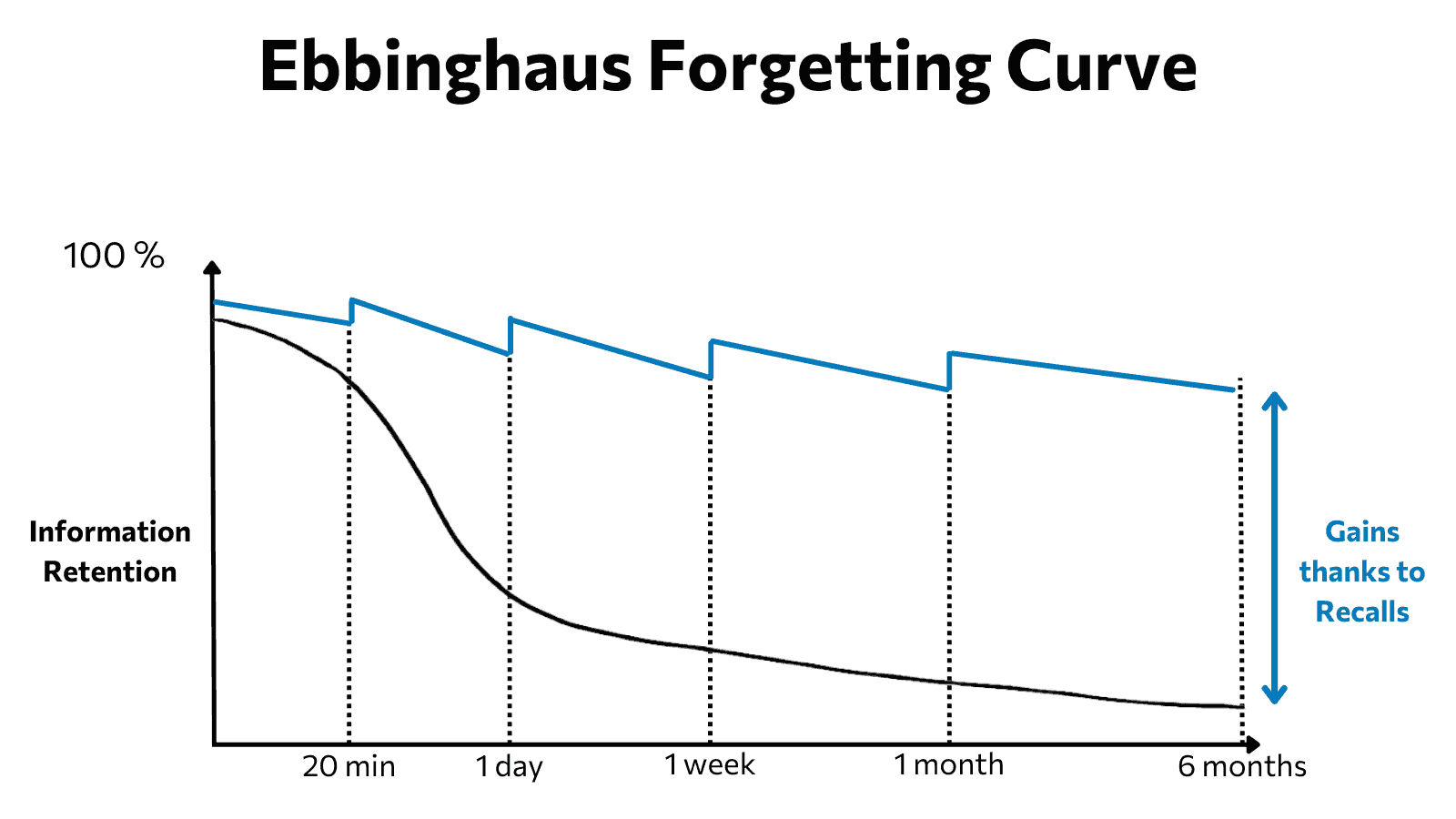Initiating a continuous improvement process is essential to boosting operational efficiency within an organization. However, sustaining it is even more crucial.
In line with the Ebbinghaus curve, which underlines the importance of repetition for retention, maintaining initial momentum requires regular rituals and conscious repetition of improvement principles. Without this continuity, the risk of disengagement, stagnation, or even forgetting good practices, becomes worrying.
To really consolidate the benefits of continuous improvement, it is essential to transform it into an integrated routine, anchored in the organizational culture. It is this consistency that will ensure continuous adaptation, capture opportunities, and move towards sustainable operational excellence.
In this article, discover how the Ebbinghaus Curve theory sheds light on the path to judicious implementation of rituals for successful and sustainable continuous improvement management.
The Ebbinghaus Curve or the Forgetting Curve: maximizing information retention
Hermann Ebbinghaus’ theory
The Ebbinghaus Curve is a key concept in psychology, named for German psychologist Hermann Ebbinghaus, a pioneer in the study of memory. Known as the Forgetting Curve, it illustrates the decline in a person’s ability to retain information over time.
Ebbinghaus conducted experiments on himself in the 19th century to study memorization and forgetting. The results of his experiments were represented in the form of a graph, which became known as the Ebbinghaus curve.

Here’s what Hermann Ebbinghaus highlighted:
- Rapid initial forgetting: Immediately after learning, information is quickly forgotten. Ebbinghaus found that a substantial amount of information is lost within 20 minutes of learning, and even more in the hours that follow.
- Decreasing forgetting rate: The rate of forgetting decreases over time. After a certain point, remaining memories tend to be more durable.
- Impact of repetition: Ebbinghaus also discovered that whenever a piece of information is reviewed or repeated, the forgetting curve for that information becomes less pronounced. In other words, repetition spaced over time improves information retention.
A formula to adopt in a professional context
In a professional context, the speed of forgetting according to the Ebbinghaus Curve underlines the crucial importance of maintaining effective communication and impactful meetings to foster employee engagement.
Who hasn’t experienced the rapid forgetting of information shared during a meeting? To maximize the effectiveness of exchanges, it’s essential that management integrate regular reminders and repetition practices into their corporate communication initiatives.
In a similar way, the Ebbinghaus Curve underlines the vital role of regular rituals within an organization. These rituals provide opportunities for repetition, reinforcement of learning, and prevention of forgetting. They become key moments for consolidating important information, promoting better retention and application of knowledge daily.
The memorization importance in continuous improvement processes
The repetition principle can be found in the rituals of continuous improvement, innovation, and transformation.
These rituals play a crucial role in providing a framework, structure and regularity for the organization and management. They make it possible to:
- Define a framework that reduces uncertainty and maintains order;
- Maintain focus on objectives and remind people of actions to be taken;
- Reinforce the innovation culture and progress by demonstrating the importance attached to the process;
- Create a space for communication and collaboration;
- Identify opportunities and solve problems;
- Track the effectiveness of actions, learn from failures, and celebrate successes.
The repetitive nature of these rituals helps to anchor the information within the teams concerned.
Repetition is the mother of learning.
The proverb “Repetition is the mother of learning” sums up the widely accepted idea that repetition is a key mechanism for reinforcing learning and memorization.
The rituals of continuous improvement, innovation and transformation and the Ebbinghaus curve are intrinsically linked to the way information is repeated, retained and applied within an organization.
- Repetition and Retention: The Ebbinghaus Curve shows that repetition is essential for information retention. Regular rituals (such as follow-up meetings, process reviews, etc.) are crucial to ensure that action items, and best practices are not forgotten, but rather integrated and reinforced on a regular basis.
- Reinforcing learning: Rituals help to reinforce what has been learned from failures and successes. Allowing teams to reflect regularly on what worked and what didn’t, reinforces learning and improvement.
- Preventing forgetting: According to the Ebbinghaus curve, the time when forgetting is most significant is shortly after learning. Rituals help to prevent this phenomenon by regularly recalling and revising knowledge and skills.
- Feedback, Adaptation and Continuous Improvement: Rituals provide regular opportunities to discuss progress, challenges and solutions, and get feedback. They enable teams to adjust quickly and improve.
Declarations of intent, always useful for defining strategic orientations, are ineffective for driving continuous improvement, innovation and transformation. Without regular follow-up, the chances of success will quickly disappear:
- The peak of interest will quickly fade,
- The need for continuous adaptation and responsiveness to change will be virtually impossible,
- The often-simplistic approach that fails to consider the complexity of the organization, and the disconnect with day-to-day practices, will contribute to the disengagement of teams,
- The lack of regular exchange and feedback will prevent opportunities from being seized and necessary adjustments from being made.
Rituals are therefore an essential pillar in the animation and management of a continuous improvement, innovation and transformation process.

Operational performance management: how to implement it?
Best practices for boosting your teams’ performance
Here are some examples of rituals you can use to boost your teams’ performance.
Which rituals to keep action plans moving?
Whether to raise corporate standards, eliminate irritants or improve productivity (…), elaborate action plans remains essential to guide and stimulate continuous improvement efforts. To ensure that the uncertainties inherent in action plans do not affect their effective operation, it is essential to communicate through regular rituals.
In the context of industrial companies, short-interval management (SIM), rituals derived from Lean, can play a crucial role in the effective management of continuous improvement rituals. SIMs are frequent, short meetings which focus on the rapid analysis of operational performance.
For example, in a manufacturing factory, regular SIMs can be organized to review key performance indicators (KPIs) related to production, quality and safety. These meetings enable teams to quickly identify potential problems, analyze the underlying causes and implement immediate corrective actions.
Managers play an essential role in implementing these SIMs, ensuring that they are focused on the company’s specific objectives and reacting quickly to changes. This dynamic approach promotes faster, more effective continuous improvement within the industrial company’s operational processes.
Keys to successful performance management
- Encourage innovation: Create an environment that fosters creativity and innovation. Encourage team members to come up with new ideas and explore innovative approaches.
- Streamlining communication and collaboration: Giving teams the resources to coordinate not only reinforces the effectiveness of rituals, but also the fluidity of exchanges needed to maximize organizational performance. This is exactly what the SDIS 58 (French departmental fire and rescue service) wanted to achieve by adopting the IDhall solution, as evidenced by their testimonial, which you can find here.
- Show employees’ recognition: Value and reward individual and collective achievements. This reinforces motivation and a sense of accomplishment.
Acquiring a management and steering tool
To animate and pilot continuous improvement rituals, it’s best not to rely on scattered Excel files, but rather to opt for a ready-to-use digital and collaborative solution. Management needs to be visual and dynamic, encouraging efficient management of rituals.
Work management tools like IDhall help maximize efficiency by standardizing processes, simplifying workflows, and ensuring optimal synchronization within your team. IDhall makes it possible to centralize improvement initiatives emanating from the field, and to consistently monitor continuous improvement and transformation projects.
If you would like to go a step further to structure your approach, take a look at our mini-guide ‘The “GOA” triptych: Organizing for performance’.





